
Developing a high-quality wallet that meets security standards, offers a great user experience, and provides robust features is not easy. Many entrepreneurs and developers face the challenge of building a wallet that supports multiple cryptocurrencies while ensuring integration with blockchain networks.
However, with the right approach, it’s possible to build a wallet that rivals the best in the market. By focusing on blockchain integration, encryption methods, and cross-platform compatibility, developers can create a wallet that users trust and love. Recently, Phantom Wallet is gained much traction.
In 2025, Phantom Wallet will have surpassed 15 million active users monthly, reflecting significant adoption and growth in the crypto space.
In this guide, we’ll explore the essential steps to help you build a wallet like Phantom, from concept to launch, things to consider when creating a wallet like Phantom, and more. Let’s get started!
What Makes Phantom Wallet Unique?
The main characteristic of Phantom Wallet is that it is non-custodial, and this implies that users maintain full control over their digital assets and keys but do not hold them on file in Phantom. It is a user-friendly platform that provides browser extensions and a mobile app for managing multiple cryptocurrencies and NFTs, particularly within the Solana blockchain environment. Phantom also provides a means for interacting with decentralized finance (DeFi) marketplaces and apps.
Here is a more thorough explanation of what makes Phantom Wallet unique:
- Non-custodial: Users are completely in charge of their funds and can interact with multiple blockchains since Phantom Wallet Solana does not hold their seed phrase or private keys.
- Multi-support of blockchains: While Phantom was originally developed for the Solana blockchain, the app now supports Ethereum, Base, Polygon, and Bitcoin so that users can handle assets in different networks.
- Easy-to-use interface: The Phantom Wallet app boasts a contemporary design, and an easy-to-use interface, which makes it accessible for both beginners and experienced users of cryptocurrencies and NFTs.
- Browser extension and mobile app: Users can access Phantom Wallet through a mobile app (iOS and Android) or a browser extension (for popular browsers such as Chrome, Firefox, Brave, and Edge), providing ease and convenience.
- NFT Administration and DeFi Integration: Phantom is a link for NFT administration and enables communication between users and their dApps or DeFi platforms.
How To Develop a Wallet Like Phantom?
Developing a wallet like Phantom involves building a secure, user-friendly crypto wallet tailored for Solana blockchain users. Follow this step-by-step guide to start a wallet like Phantom on your own:
1. Define Core Features
Identifying the essential features your wallet must support to meet user expectations and match industry standards. Likewise, features of Phantom Wallet include:
- Secure key management
- Send/receive Solana and SPL tokens
- Token swapping
- NFT storage and management
- Staking functionality
Read Also: AI-Integrated Smart Crypto Wallet
2. Choose the Right Blockchain Infrastructure
Select the appropriate blockchain tools and protocols to ensure smooth functionality—when building for Solana, this includes working with its JSON RPC API, SPL token standards, and key developer libraries like Solana Web3.js and SDKs.
- Work with SPL token standards
- Utilize the Solana SDK and Web3.js libraries
3. Design UI/UX for Accessibility
Design a wallet interface that’s visually clean, easy to navigate, and optimized for both beginners and pros:
- Easy onboarding (create/import wallet)
- QR code functionality for sending/receiving
- Clear transaction history and wallet activity
4. Implement Security Protocols
Security must be built into every layer of your wallet, from generating and backing up seed phrases to encrypting private keys.
- Biometric login and password protection
- Secure transaction signing and verification
5. Integrate Web3 Functionalities
Allow users to interact directly with decentralized apps (dApps), stake tokens, and perform in-app swaps to ensure:
- Add support for Web3 dApp connections via injected wallet providers
- Enable token swaps using Serum or Jupiter Aggregator on Solana
- Integrate staking features directly within the wallet interface
6. Develop Browser Extension and Mobile App
Offer users a consistent and responsive wallet experience across devices by building a browser extension using :
- Frameworks like React or Svelte for the browser extension
- Build native or hybrid apps for iOS and Android using Flutter, React Native, or Swift/Kotlin
7. Test Thoroughly Before Launch
Ensure your wallet functions reliably in all scenarios by conducting detailed UI testing and blockchain interaction checks, like:
- Smart contract interactions
- UI responsiveness
- Security audits
- Stress and load tests
- Beta testing with real users
8. Launch & Offer Continuous Support
After going live, maintain momentum by monitoring performance, releasing regular updates, and patching bugs:
- Monitor performance and usage analytics
- Identify vulnerabilities promptly
- Offer user support and documentation
Read Also: Hot vs Cold Crypto Wallets
Why Build a Wallet like Phantom?

Opening a wallet such as Phantom can be a strategic move if you wish to take advantage of the explosive universe of crypto and Web3. Phantom is well-liked because it provides an easy, secure method for users to hold, send, and exchange cryptocurrencies, particularly on the Solana blockchain, which is renowned for low costs and speedy transactions.
With the growth of decentralized applications (dApps), NFTs, and DeFi platforms, users require wallets that are not only secure but also user-friendly. Here are some benefits of a phantom wallet, which is why users should build a wallet like Phantom:
1. High Demand in Web3 Ecosystem: Phantom has millions of users and is growing, proving the market need for smooth crypto wallets.
2. User-Friendly Interface: Simple, sleek, and intuitive UX attracts both beginners and pros in the crypto space.
3. Multi-Chain Support: Phantom now supports Solana, Ethereum, and Polygon—users want flexibility.
4. All-in-one platform: Multiple features like DeFi, NFTs, and staking can all be performed and managed in one place, which boosts user engagement and retention.
5. Strong Community and Open Ecosystem: Wallets like Phantom become central to the Web3 experience (e.g., DeFi apps, games, NFT platforms).
6. Security-First Architecture: Phantom security with private key control and phishing protection—a must-have for any wallet.
Read Also: Build a dApps on Solana
Things To Consider When Creating A Wallet Like Phantom
When creating a wallet like Phantom, it’s important to focus on several key aspects to ensure it meets user expectations, stands out in a competitive market, and prioritizes security.
- Security: Ensure robust encryption and multi-factor authentication to protect users’ assets. Wallets like Phantom use features such as seed phrases and password protection to prevent hacks.
- User Experience (UX): A user-friendly and intuitive interface is crucial. Phantom’s simple design makes it easy for both beginners and experienced crypto users to navigate.
- Blockchain Integration: Support for popular blockchains like Solana, Ethereum, or others helps expand the wallet’s usability. Make sure it’s multi-chain compatible for a larger user base.
- Cross-platform Support: Phantom is available on both desktop and mobile, making it accessible for users wherever they are. Expanding to different platforms increases user adoption.
- Speed and Efficiency: Low transaction fees and fast transaction processing are essential features that users expect from a wallet. Phantom excels by utilizing the Solana blockchain for speed.
How Much Does It Cost to Build a Wallet Like Phantom?
Building a wallet like Phantom (a popular Solana-based crypto wallet) involves several factors, including design, development, security, and marketing. Partnering with a crypto wallet development company can help improve the process.
The cost typically ranges from $50,000 to $150,000, depending on the complexity of the features, the development team’s location, and the timeline.
- User Interface (UI) and User Experience (UX) Design
- Blockchain Integration for Solana, Ethereum, or other networks
- Security Features like encryption, backup, and two-factor authentication
- Cross-Platform Support for iOS, Android, and web extensions
You’ll also need to consider ongoing maintenance, updates, and compliance with regulatory standards.
Conclusion
Creating a wallet like Phantom requires a deep understanding of blockchain technology, security protocols, and a user-friendly design.
You’ll need a skilled development team to integrate multiple networks, ensure top-notch security, and offer cross-platform support. The development process is complex but achievable with the right resources.
As the demand for crypto wallets grows, focusing on a user experience will be key to success. Whether you’re building for Solana or another blockchain, attention to detail in both functionality and design will set your wallet apart.
SoluLab, a crypto wallet development company, can help you create a wallet like Phantom and solve all the queries you’ve about the same. Contact us today to discuss further.
FAQs
1. What are the best tools for developing a wallet like Phantom?
Popular tools include React for the front end, Solana Web3.js for blockchain interaction, and Web3.js for Ethereum-based integrations. You’ll also need Metamask for wallet connection and Node.js for backend development.
2. How do I ensure my wallet is safe?
To assure top-level security, implement end-to-end encryption, multi-signature features, and secure key management practices while using the wallet. Regular security audits are also essential.
3. Do you offer white-label wallet solutions?
Yes! We provide white-label wallet development for businesses looking to launch fast with custom branding. These solutions are fully secure, scalable, and ready to integrate with various tokens, dApps, and DeFi protocols.
4. How do I integrate wallet functionalities with blockchain?
Use blockchain-specific libraries like Solana Web3.js or Web3.js for Ethereum, allowing interaction with blockchain networks for transactions, account creation, and balances. Consider partnering with a crypto wallet development company to ensure integration and professional development for your wallet project.
5. How long does it take to develop a crypto wallet like Phantom?
Typically, wallet development takes 3 to 6 months, but the actual time depends on the complexity, features, and other business requirements for your custom wallet platform.






